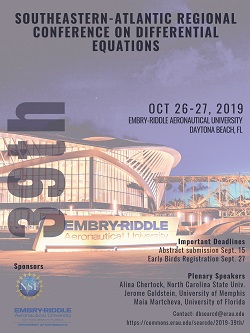Institution
University of Cincinnati
Abstract
Abstract We study the evolution of the stable and unstable manifolds of an equilibrium point of a Hamiltonian system of two degrees of freedom which depends on a parameter ν. The eigenvalues of the linearized system are pure imaginary for ν < 0 and complex with nonzero real part for ν > 0. (These are the same basic assumptions as found in the Hamiltonian-Hopf bifurcation theorem of the authors.) For ν > 0 the equilibrium has a two-dimensional stable manifold and a two-dimensional unstable manifold, but for ν < 0 there are no longer stable and unstable manifolds attached to the equilibrium. We study the evolution of these manifolds as the parameter is varied. If the sign of a certain term in the normal form is positive then for small positive ν the stable and unstable manifolds of the system are either identical or must have transverse intersection. Thus, either the system is totally degenerate or the system admits a suspended Smale horseshoe as an invariant set. This happens at the Lagrange equilibrium point L4 of the restricted three-body problem at the Routh critical value µ1. On the other hand if the sign of this term in the normal form is negative then for ν = 0 the stable and unstable manifolds persists and then as ν decreases from zero they detach from the equilibrium to follow a hyperbolic periodic solution. Joint work with Dieter Schmidt.
Invariant Manifolds in the Hamiltonian-Hopf Bifurcation
Abstract We study the evolution of the stable and unstable manifolds of an equilibrium point of a Hamiltonian system of two degrees of freedom which depends on a parameter ν. The eigenvalues of the linearized system are pure imaginary for ν < 0 and complex with nonzero real part for ν > 0. (These are the same basic assumptions as found in the Hamiltonian-Hopf bifurcation theorem of the authors.) For ν > 0 the equilibrium has a two-dimensional stable manifold and a two-dimensional unstable manifold, but for ν < 0 there are no longer stable and unstable manifolds attached to the equilibrium. We study the evolution of these manifolds as the parameter is varied. If the sign of a certain term in the normal form is positive then for small positive ν the stable and unstable manifolds of the system are either identical or must have transverse intersection. Thus, either the system is totally degenerate or the system admits a suspended Smale horseshoe as an invariant set. This happens at the Lagrange equilibrium point L4 of the restricted three-body problem at the Routh critical value µ1. On the other hand if the sign of this term in the normal form is negative then for ν = 0 the stable and unstable manifolds persists and then as ν decreases from zero they detach from the equilibrium to follow a hyperbolic periodic solution. Joint work with Dieter Schmidt.

